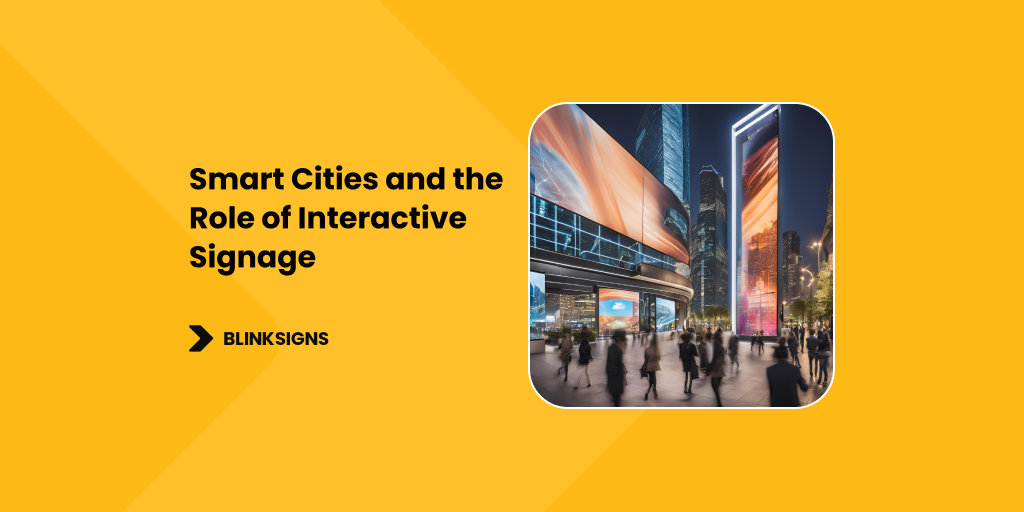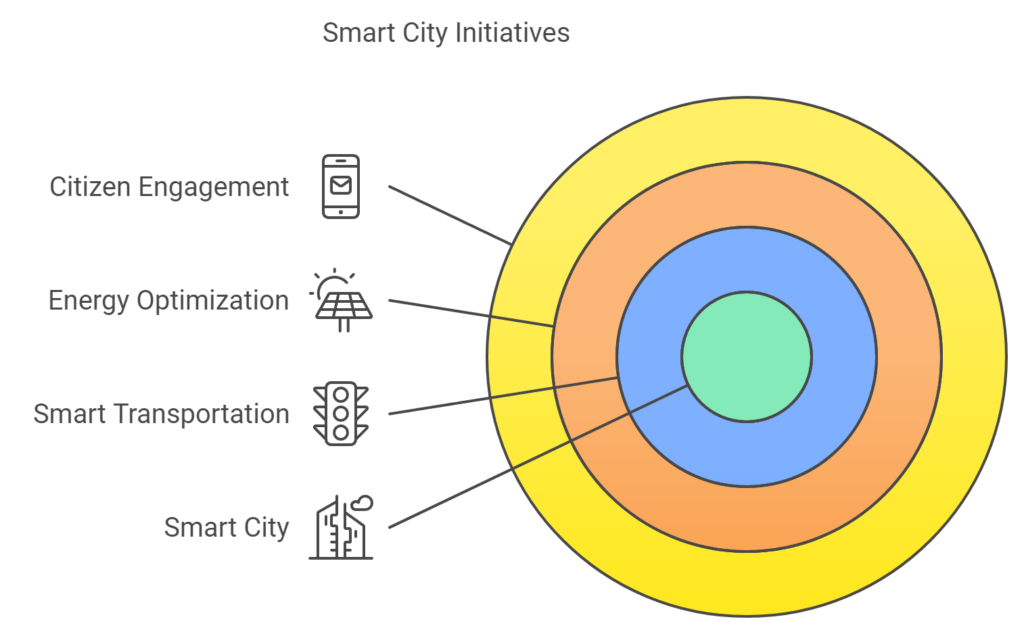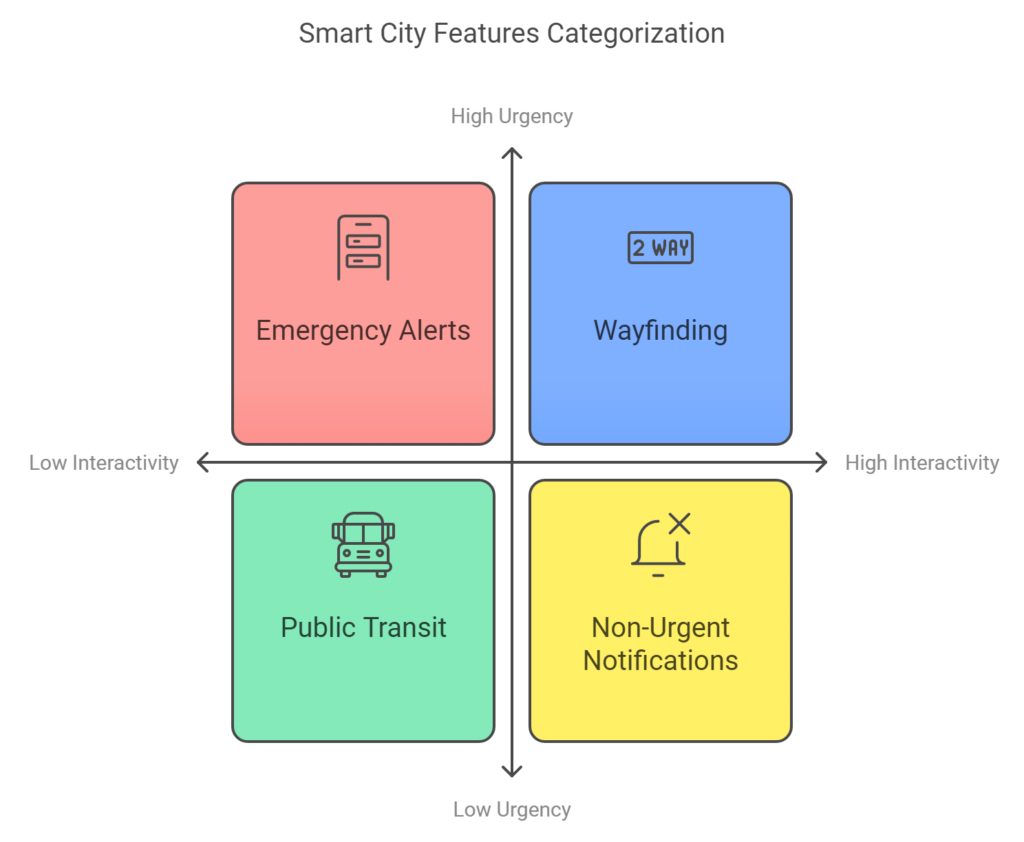
Smart Cities and the Role of Interactive Signage
As urbanization continues to reshape our cities, smart cities have emerged, blending advanced technologies to improve urban living. One key innovation transforming these cities is interactive signage.
More than just a tool for information, interactive signage plays a pivotal role in managing urban infrastructure, enhancing public services, and engaging citizens in smart cities. Blinksigns delivers cutting-edge interactive signage solutions that help cities modernize their communication and infrastructure, fostering better connectivity, safety, and sustainability.
What Are Smart Cities?
Smart cities integrate digital technologies, data collection, and advanced communication systems to enhance the quality of urban living. Key components include IoT (Internet of Things) devices, big data analytics, and real-time information systems. These interconnected technologies improve energy management, public safety, transportation, and city services.
A smart city operates through:
- Smart transportation: real-time traffic control and dynamic public transport updates.
- Energy optimization: Renewable energy grids and solar-powered public infrastructure.
- Citizen engagement: Interactive platforms, such as digital kiosks and mobile apps, help citizens access city services and real-time updates.

Smart City Initiatives
The Impact of Interactive Signage in Smart Cities
Interactive signage in smart cities facilitates communication between residents, visitors, and the urban infrastructure. These digital platforms go beyond static information, offering real-time, interactive solutions that improve navigation, public safety, and access to city services.
Key applications of interactive signage include:
- Wayfinding: Providing dynamic, real-time directions for pedestrians and vehicles.
- Public transit: Displaying live updates on bus arrivals, train departures, and delays.
- Emergency alerts: Broadcasting critical information during emergencies, from evacuation routes to weather updates.

Smart City Features
Interactive signage helps cities manage large data volumes, connecting citizens directly to city services, transportation networks, and public safety systems.
Interactive Signage and Real-Time Data Solutions
Access to real-time data is essential for maintaining efficient public services and transportation systems in smart cities. Interactive signage uses city-wide data networks to provide residents and visitors with up-to-date information in public spaces, enhancing urban mobility and decision-making.
For example:
- Traffic management: Smart signs show drivers traffic conditions and alternate routes, helping to reduce congestion.
- Public transport updates: Interactive displays at bus stops and train stations provide real-time information on schedules, delays, and route changes.
- Weather conditions: Signs can display weather alerts, enabling citizens to plan their activities accordingly.
Blinksigns’ interactive signage solutions seamlessly integrate with smart city data, providing immediate and accurate information that enhances urban navigation and public safety.
Improving Accessibility Through Smart Signage
One of the essential aspects of smart city infrastructure is accessibility. Interactive signage offers innovative solutions to ensure that public spaces are inclusive to all, including individuals with disabilities. Features like voice navigation, braille touchscreens, and multi-language support on interactive signs help all citizens interact with city services more easily.
Blinksigns’ interactive signage systems are customizable and meet various accessibility standards, ensuring that public information is available to everyone. This improves engagement and makes city services more accessible, regardless of language or physical ability.
Interactive Signage Use Cases in Smart Cities
| Use Case | Function | Impact on City |
| Wayfinding | Provides real-time directions for pedestrians and vehicles | Eases navigation, reduces congestion |
| Public Transit | Live updates on bus, train, and subway schedules | Improves commute efficiency, reduces wait times |
| Emergency Alerts | Broadcasts alerts and emergency evacuation routes | Enhances public safety during crises |
| Tourist Information | Interactive maps and guides to local attractions and services | Boosts tourism, promotes local businesses |
The Role of Smart Transportation in Urban Mobility
Interactive signage plays a crucial role in smart parking systems within smart cities. These systems guide drivers to available parking spots, reducing traffic congestion and improving urban mobility. Smart parking signs display live parking availability in real-time, optimizing parking space usage and reducing the time drivers spend searching for spots.
Blinksigns’ interactive parking solutions integrate real-time data on parking availability, offering cities an effective tool to manage traffic while promoting eco-friendly solutions by reducing the carbon emissions associated with unnecessary driving.
- Key benefits of smart parking solutions include:
- Reducing traffic congestion.
- Improving the driver experience.
- Lowering emissions through reduced vehicle idling times.
Enhancing Public Transportation with Interactive Digital Signage
Public transportation is a critical component of any smart city, and interactive digital signage optimizes this service by providing commuters with real-time updates on transportation schedules. Digital displays located at bus stops, subway stations, and transit hubs inform travellers of bus and train arrivals, route changes, and delays.
Interactive signage enhances the commute experience by offering:
- Real-time travel information: Immediate updates on arrival and departure times.
- Route planning: digital kiosks that help travellers find the quickest routes to their destinations.
- Alerts: Notifications of service changes or emergency situations.
Blinksigns’ transportation signage solutions ensure that cities can offer residents and visitors a seamless, real-time transit experience, improving public transportation efficiency and commuter satisfaction.
Using Interactive Signage for Emergency Communication
Public safety is one of the most crucial applications of interactive signage in smart cities. In emergency situations, such as natural disasters, fires, or public health crises, interactive signage can provide life-saving information to citizens in real time. These systems broadcast emergency alerts, direct citizens to safe zones, and provide up-to-date information on the situation.
In addition to emergency alerts, interactive signs serve as a communication tool for public health, warning citizens about ongoing health crises and providing information on vaccination drives, hygiene guidelines, and public health protocols.
Blinksigns’ emergency signage solutions are designed to connect with city-wide alert systems, ensuring that critical information reaches citizens promptly and contributing to enhanced public safety in urban environments.
Sustainability and Energy Efficiency in Smart Cities
Sustainability is a core goal for modern smart cities. Interactive signage helps reduce environmental impact by offering energy-efficient solutions such as solar-powered signage. Solar-powered systems reduce electricity usage, contributing to the city’s sustainability efforts and carbon emission reduction.
Blinksigns specializes in solar-powered interactive signage that integrates seamlessly with a city’s infrastructure. This ensures that energy consumption is minimized without compromising functionality or performance.
Interactive Signage and City Sustainability Goals
Interactive signage supports smart cities’ sustainability goals by minimizing paper use, reducing energy consumption, and offering real-time updates that reduce waste from printed materials. By opting for eco-friendly signage solutions, cities can promote green initiatives while providing modern, dynamic services to their citizens.
Blinksigns’ eco-friendly signage solutions help cities meet their sustainability targets by offering advanced, energy-efficient systems that reduce environmental impact and enhance public services.
The Future of Smart Cities with Interactive Signage
Interactive signage transforms how cities operate, communicate, and engage with residents. As smart cities continue to evolve, Blinksigns’ interactive signage solutions play a pivotal role in enhancing urban efficiency, improving accessibility, and promoting sustainability. From smart transportation systems to real-time emergency alerts, interactive signage is a key technology that supports the development of more connected, responsive, and environmentally conscious cities.
Partner with Blinksigns to implement interactive digital signage in your smart city and help shape a more sustainable, connected future.